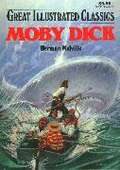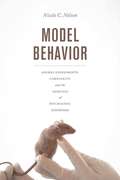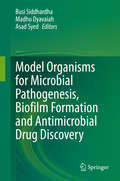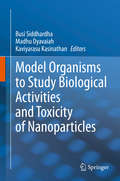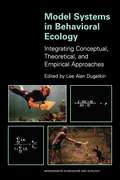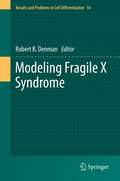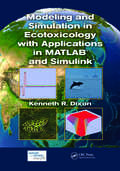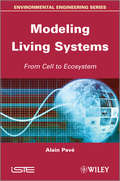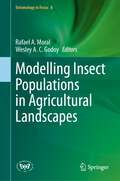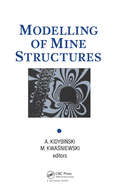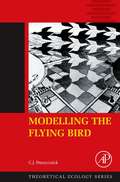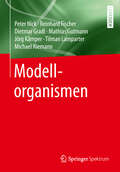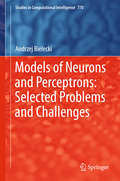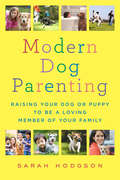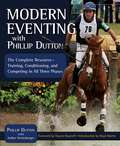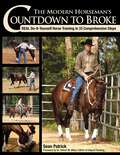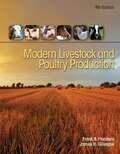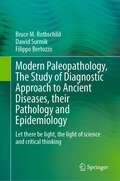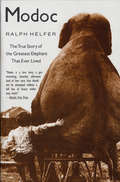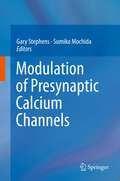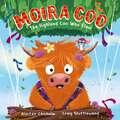- Table View
- List View
Moby Dick (Great Illustrated Classics)
by Herman MelvilleMoby Dick (Great Illustrated Classics) is the world's best-loved children's stories set in large type for easy reading.
Moby Dog (Adventures of Wishbone #10)
by Alexander SteeleMOBY DOG A test of courage . . . A stormy sea voyage . . . A really big whale! Someone has run off with Joe Talbot's basketball someone wearing a White Whales team emblem. Joe and Wishbone decide they will get it back, no matter what. This incident reminds Wishbone of the great sea adventure Moby Dick. He imagines himself as the sailor Ishmael on board a great whaling ship under the command of peg-legged Captain Ahab. They are on the quest of a lifetime, as they chase a great white whale across the seven seas. When the ship comes face-to-face with this menacing creature, only a hero with a courageous canine heart and four mighty sea legs will be able to keep his head above water. Thar she blows!
Model Behavior: Animal Experiments, Complexity, and the Genetics of Psychiatric Disorders
by Nicole C. NelsonMice are used as model organisms across a wide range of fields in science today—but it is far from obvious how studying a mouse in a maze can help us understand human problems like alcoholism or anxiety. How do scientists convince funders, fellow scientists, the general public, and even themselves that animal experiments are a good way of producing knowledge about the genetics of human behavior? In Model Behavior, Nicole C. Nelson takes us inside an animal behavior genetics laboratory to examine how scientists create and manage the foundational knowledge of their field. Behavior genetics is a particularly challenging field for making a clear-cut case that mouse experiments work, because researchers believe that both the phenomena they are studying and the animal models they are using are complex. These assumptions of complexity change the nature of what laboratory work produces. Whereas historical and ethnographic studies traditionally portray the laboratory as a place where scientists control, simplify, and stabilize nature in the service of producing durable facts, the laboratory that emerges from Nelson’s extensive interviews and fieldwork is a place where stable findings are always just out of reach. The ongoing work of managing precarious experimental systems means that researchers learn as much—if not more—about the impact of the environment on behavior as they do about genetics. Model Behavior offers a compelling portrait of life in a twenty-first-century laboratory, where partial, provisional answers to complex scientific questions are increasingly the norm.
Model Organisms for Microbial Pathogenesis, Biofilm Formation and Antimicrobial Drug Discovery
by Busi Siddhardha Madhu Dyavaiah Asad SyedThis book provides essential insights into microbial pathogenesis, host-pathogen interactions, and the anti-microbial drug resistance of various human pathogens on the basis of various model organisms. The initial sections of the book introduce readers to the mechanisms of microbial pathogenesis, host-pathogen interactions, anti-microbial drug resistance, and the dynamics of biofilm formation. Due to the emergence of various microbial resistant strains, it is especially important to understand the prognosis for microbial infections, disease progression profiles, and mechanisms of resistance to antibiotic therapy in order to develop novel therapeutic strategies. In turn, the second part of the book presents a comparative analysis of various animal models to help readers understand microbial pathogenesis, host-pathogen interactions, anti-microbial drug discovery, anti-biofilm therapeutics, and treatment regimes. Given its scope, the book represents a valuable asset for microbiologists, biotechnologists, medical professionals, drug development researchers, and pharmacologists alike.
Model Organisms to Study Biological Activities and Toxicity of Nanoparticles
by Busi Siddhardha Madhu Dyavaiah Kaviyarasu KasinathanThis book provides a comprehensive overview of state-of-the-art applications of nanotechnology in biology and medicine, as well as model organisms that can help us understand the biological activity and associated toxicity of nanoparticles, and devise strategies to minimize toxicity and enhance therapies. Thanks to their high surface-to-volume ratio, nanoparticles are characterized by excellent biocompatibility and bioavailability, a high therapeutic index, and relatively low toxicity, which has led to their widespread application in the early diagnosis of diseases, comprehensive monitoring of disease progression, and improved therapeutics. The book also explores nanoparticle-based insecticides and their mechanisms of action, and provides a comparative analysis of the various model organisms that are used to understand the biological properties of nanoparticles. Further, it describes various in-vivo models that yield important insights into nanomaterial-mediated toxicity, promoting the optimal utilization of nanoparticles. In closing, the book discusses future perspectives and regulatory issues concerning the use of nanomaterials in translational research.
Model Systems in Behavioral Ecology: Integrating Conceptual, Theoretical, and Empirical Approaches
by Lee Alan DugatkinA key way that behavioral ecologists develop general theories of animal behavior is by studying one species or a closely related group of species--''model systems''--over a long period. This book brings together some of the field's most respected researchers to describe why they chose their systems, how they integrate theoretical, conceptual, and empirical work, lessons for the practice of the discipline, and potential avenues of future research. Their model systems encompass a wide range of animals and behavioral issues, from dung flies to sticklebacks, dolphins to African wild dogs, from foraging to aggression, territoriality to reproductive suppression. <p><p> Model Systems in Behavioral Ecology offers an unprecedented ''systems'' focus and revealing insights into the confluence of personal curiosity and scientific inquiry. It will be an invaluable text for behavioral ecology courses and a helpful overview--and a preview of coming developments--for advanced researchers. The twenty-five chapters are divided into four sections: insects and arachnids, amphibians and reptiles, birds, and mammals.
Modeling Fragile X Syndrome
by Robert B. DenmanIntroduction.-Probing Astrocyte Function in Fragile X Syndrome.- Neural Stem Cells.- Fragile X Mental Retardation Protein (FMRP) and the Spinal Sensory System.- The Role of the Postsynaptic Density in the Pathology of the Fragile X Syndrome.- Behavior in a Drosophila model of Fragile X.- Molecular and Genetic Analysis of the Drosophila Model of Fragile X Syndrome.- Fragile X Mental Retardation Protein and Stem Cells.- Manipulating the Fragile X Mental Retardation Proteins in the Frog.- Exploring the Zebra finch Taeniopygia gutta as a Novel Animal Model for the Speech-language Deficit of Fragile X Syndrome.- Neuroendocrine Alterations in the Fragile X Mouse.- Taking STEPs forward to understanding Fragile X Syndrome.- Fmr-1 as an Offspring Genetic and a Maternal Environmental Factor in Neurodevelopmental Disease.- Mouse Models of the Fragile X Premutation and the Fragile X Associated Tremor/Ataxia Syndrome.- Clinical Aspects of the Fragile X Syndrome.- Fragile X Syndrome: A Psychiatric Perspective.- Fragile X Syndrome and Targeted Treatment Trials.- The Fragile X-associate Tremor Ataxia Syndrome.- Vignettes: Models in Absentia.
Modeling Phase Transitions in the Brain
by D. Alistair Steyn-Ross Moira Steyn-Ross Walter FreemanForeword by Walter J. Freeman. The induction of unconsciousness using anesthetic agents demonstrates that the cerebral cortex can operate in two very different behavioral modes: alert and responsive vs. unaware and quiescent. But the states of wakefulness and sleep are not single-neuron properties---they emerge as bulk properties of cooperating populations of neurons, with the switchover between states being similar to the physical change of phase observed when water freezes or ice melts. Some brain-state transitions, such as sleep cycling, anesthetic induction, epileptic seizure, are obvious and detected readily with a few EEG electrodes; others, such as the emergence of gamma rhythms during cognition, or the ultra-slow BOLD rhythms of relaxed free-association, are much more subtle. The unifying theme of this book is the notion that all of these bulk changes in brain behavior can be treated as phase transitions between distinct brain states. Modeling Phase Transitions in the Brain contains chapter contributions from leading researchers who apply state-space methods, network models, and biophysically-motivated continuum approaches to investigate a range of neuroscientifically relevant problems that include analysis of nonstationary EEG time-series; network topologies that limit epileptic spreading; saddle--node bifurcations for anesthesia, sleep-cycling, and the wake--sleep switch; prediction of dynamical and noise-induced spatiotemporal instabilities underlying BOLD, alpha-, and gamma-band Hopf oscillations, gap-junction-moderated Turing structures, and Hopf-Turing interactions leading to cortical waves.
Modeling and Simulation in Ecotoxicology with Applications in MATLAB and Simulink
by Kenneth R. DixonExploring roles critical to environmental toxicology, Modeling and Simulation in Ecotoxicology with Applications in MATLAB and Simulink covers the steps in modeling and simulation from problem conception to validation and simulation analysis. Using the MATLAB and Simulink programming languages, the book presents examples of mathematical functions a
Modeling of Living Systems: From Cell to Ecosystem
by Alain PavéModeling is now one of the most efficient methodologies in life sciences. From practice to theory, this book develops this approach illustrated by many examples; general concepts and the current state of the art are also presented and discussed. An historical and general introduction informs the reader how mathematics and formal tools are used to solve biological problems at all levels of the organization of life. The core of this book explains how this is done, based on practical examples coming, for the most part, from the author’s personal experience. In most cases, data are included so that the reader can follow the reasoning process and even reproduce calculus. The final chapter is devoted to essential concepts and current developments. The main mathematical tools are presented in an appendix to the book and are written in an adapted language readable by scientists, professionals or students, with a basic knowledge of mathematics.
Modelling Insect Populations in Agricultural Landscapes (Entomology in Focus #8)
by Rafael A. Moral Wesley A. C. GodoyThis book combines chapters emphasising mathematical, statistical, and computational modelling applied to insect populations, particularly pests or natural enemies in agricultural landscapes. There is a gap between agricultural pest experimentation and ecological theory, which requires a connection to supply models with laboratory, and field estimates and projects receiving inputs and insights from models. In addition, decision-making in entomology with respect to pest management and biological conservation of natural enemies has been supported by results obtained from different computational and mathematical approaches. This book brings contemporary issues related to optimization in spatially structured landscapes, insect movement, stability analysis, game theory, machine learning, computer vision, Bayesian modelling, as well as other frameworks.
Modelling of Mine Structures: Proceedings of the 10th plenary session of the International Bureau of Strata Mechanics, World Mining Congress, Stockholm, 4 June 1987
by A.KIDYBIŃSKI; M.KWAŚNIEWSKIProceedings of the 10th Plenary Scientific Session of the International Bureau of Strata Mechanics, World Mining Congress, Stockholm, June 1987.
Modelling the Flying Bird
by C. J. PennycuickThis book outlines the principles of flight, of birds in particular. It describes a way of simplifying the mechanics of flight into a practical computer program, which will predict in some detail what any bird, real or hypothetical, can and cannot do. The book and the program are based on adapting the conventional (and well-tested) thinking of aeronautical engineers to the biological problems of bird flight. Their primary aim is to convince biologists that this is the appropriate way to handle problems that involve flight, to make the engineering background accessible to biologists, and to provide a tool kit in the shape of the Flight program, which they can use to solve practical problems involving bird flight and migration. In addition, the book will be readily accessible to engineers who want to know how birds work, and should be of interest to the ever-growing community working on flapping "micro air vehicles" (MAVs). The program can be used to predict the flight performance and capabilities of reconstructed fossil birds and pterosaurs, flying in ancient atmospheres that differ from present conditions, and also, of course, to predict and account for the results of experiments and observations on living birds and bats. * An up to date work by the world's leading expert on bird flight * Examines the biology and biomechanics of bird flight with added reference to the flight of bats and pterosaurs. * Uses proven aeronautical principles to help solve biological issues in understanding and predicting the flight capabilities of birds and other vertebrates. * Provides insights into the evolution of flight and the likely capabilities of extinct birds and reptiles. * Gives a detailed explanation of the science behind, and use of, the author's predictive bird flight simulation program - Flight - which is available on a companion website. * Presents often difficult concepts in easily understood language.
Modellorganismen
by Peter Nick Mathias Gutmann Reinhard Fischer Dietmar Gradl Jörg Kämper Tilman Lamparter Michael RiemannDieses Buch vermittelt ein Verständnis dafür, was Modellorganismen sind, und warum sie für die Biologie eine so wichtige Rolle spielen. Im Zentrum steht, welche grundsätzlichen Ansätze mit Modellorganismen verfolgt werden und welche Limitierungen man beachten muss. Einige Modellorganismen werden exemplarisch anhand von übersichtlichen Steckbriefen vorgestellt und ihre Anwendung wird ausführlich diskutiert. Es werden außerdem wichtige wissenschaftstheoretische Grundlagen und Grundsätze der Biologie eingehend erörtert. Dieses Buch richtet sich vor allem an Studierende im fortgeschrittenen Bachelor und im Masterbereich der Lebenswissenschaften.
Models of Neurons and Perceptrons: Selected Problems and Challenges (Studies In Computational Intelligence #770)
by Andrzej BieleckiThis book describes models of the neuron and multilayer neural structures, with a particular focus on mathematical models. It also discusses electronic circuits used as models of the neuron and the synapse, and analyses the relations between the circuits and mathematical models in detail. The first part describes the biological foundations and provides a comprehensive overview of the artificial neural networks. The second part then presents mathematical foundations, reviewing elementary topics, as well as lesser-known problems such as topological conjugacy of dynamical systems and the shadowing property. The final two parts describe the models of the neuron, and the mathematical analysis of the properties of artificial multilayer neural networks. Combining biological, mathematical and electronic approaches, this multidisciplinary book it useful for the mathematicians interested in artificial neural networks and models of the neuron, for computer scientists interested in formal foundations of artificial neural networks, and for the biologists interested in mathematical and electronic models of neural structures and processes.
Modern Book of the Black Bass
by Byron DalrympleHow to fish for black bass, selecting the best waters, getting new tackle, fly-rodding for largemouths, fishing for smallmouths, and more
Modern Dog Parenting: Raising Your Dog or Puppy to Be a Loving Member of Your Family
by Sarah HodgsonYou and your dog are a lot alike. By several behavioral measures, your dog's mental abilities are equivalent to those of a two to three and a half-year-old toddler. Dogs can learn up to 250 words, count from one to five and understand basic arithmetic. Your dog can imitate and understand your behavior and has a sense of fairness. Doesn't it make sense to treat these sensitive, intelligent creatures a bit more like children? Kids--and dogs--raised with kindness and respect grow up happy. And happy is good. Modern Dog Parenting will show readers that yes, you can love your dog and live with him, too.Dogs (and the people who love them) are tired of the school of dominant, top-dog training. They are looking for a new kind of pack leader: someone funny, enthusiastic, intuitive, approachable, and, above all, effective. And they've found her. Sarah Hodgson rejects dominance-based training and gets astonishing results with a blend of wit, compassion, energy, and proven skills. She communicates instructions clearly, directs behavior compassionately, and rewards success lavishly.Topics include:*Understanding the signs your dog is giving you*Having fun while learning manners*How to fit your dog into your lifestyle*How to communicate lovingly and effectively with your dog
Modern Eventing with Phillip Dutton
by Phillip DuttonThis fabulously illustrated book covers training, conditioning, and competing in all three phases of events: dressage, cross-country, and show jumping. In addition, Dutton includes full chapters describing the special needs of the event horse, with tips and advice from the top experts who make up his internationally respected eventing team—his groom, his farrier, and his veterinarian. You'll find guidance in everything from daily maintenance to braiding and turnout, and from hoof care and studs to common health issues and vet box care of your horse during competitions.With tips for finding the right event prospect, whatever your level of experience, as well as Dutton's own schooling exercises, both on the flat and over fences, the book promises to give you the leg up you need for a safe and confident start in the sport.Everything You Need to Excel in Eventing including:Tack & EquipmentFinding the Right HorsePutting Together an Eventing TeamHorse & Rider FitnessBasic Dressage SchoolingCross-Country: No FencesCross-Country JumpingIntroduction to Show JumpingMental Preparation for Horse & RiderWarming Up for Each PhaseRiding the Dressage TestWalking the Cross-Country CoursePlanning the Show Jumping RoundStaying Clear and Making TimeGrooming, Braiding, & Quarter MarksFeeding the Working AthleteHoof Maintenance, Shoes, & StudsCommon Health ProblemsCare of the Event Horse During CompetitionAnd So Much More!Includes 11 of Phillip's Personal Jumping Exercises!
Modern Horseman's Countdown to Broke
by Sean PatrickIt's time to get real—that is, real, do-it-yourself horse training. Professional trainer Sean Patrick has created the ultimate guide to the complete riding horse—whether a performance, working, or just for fun prospect. Quite simply, you begin at Lesson Number 33 and count your way down through the basic exercises—the primary education—every horse needs. And when you get to Lesson 1, you've done it; you've prepared your horse for advanced work in any number of equestrian disciplines. You can't get lost along the way. There's no room for confusion. Sean clarifies the point and explains the gist of every step. The happy result? He trains you to be a trainer. Whether your horse is a foal or five, guilelessly green or imperfectly veteran, he will benefit from the Countdown—a true foundation program, serving to prepare him for the endless variety of activities and jobs horses perform today. From indispensable handling, sacking-out, and tying exercises, to how you, the rider, can control the different parts of the horse’s body from the ground and the saddle; from mounting on both the left and the right to performing flawless flying lead changes, you’ll be amazed at how effective and efficient this program is.
Modern Livestock And Poultry Production, 9th, Student Edition
by James R. Gillespie Frank FlandersWith coverage of basic animal science and livestock industry information as well as current issues in animal agriculture, the Ninth Edition of MODERN LIVESTOCK AND POULTRY PRODUCTION covers everything readers need to know about all phases and types of livestock production. Through updated visual aids, real-world applications, and comprehensive study tools, this engaging book provides readers with a solid understand of the anatomy, physiology, nutrition, feeding, and reproduction of multiple livestock and poultry breeds.
Modern Livestock and Poultry Production
by Frank B. Flanders James R. GillespieWith coverage of basic animal science and livestock industry information as well as current issues in animal agriculture, the Ninth Edition of MODERN LIVESTOCK AND POULTRY PRODUCTION covers everything readers need to know about all phases and types of livestock production. Through updated visual aids, real-world applications, and comprehensive study tools, this engaging book provides readers with a solid understand of the anatomy, physiology, nutrition, feeding, and reproduction of multiple livestock and poultry breeds.
Modern Paleopathology, The Study of Diagnostic Approach to Ancient Diseases, their Pathology and Epidemiology: Let there be light, the light of science and critical thinking
by Bruce M. Rothschild Dawid Surmik Filippo BertozzoThe study of paleopathology has two very different constituencies, the medical scientist and the zoologist/paleontologist/anthropologist. Their investigative procedures and professional jargon are different, sometimes to the point of mutual incomprehensibility. Paleontologists/anthropologists/zoologists have a limited data base for the characterization and interpretation of pathology. This must come from the human and veterinary medical experience.What, beyond intellectual satisfaction, can the health care community expect from this relationship? The past history of the appearance and dispersal of infectious disease and cancer is of considerable theoretical importance and leads to new insights on the nature and transmission of diseases that are otherwise ambiguous. The discovery of rheumatoid arthritis in pre-Columbian North America exemplifies insights gained.The current effort delineates osseous impact of disease (as manifest in clinical populations diagnosed in life), representation in the zoologic, paleontologic and anthropologic record, and assessment techniques that can be confidently applied. The chapters form “columns” that provide the foundation for scientific critical thinking. The actual integration of the information is in its application. Our purpose is to provide a data base and atlas of actually documented skeletal impact of diseases (as population phenomenon), an initial data base of reported skeletal pathology, and a methodology for expanding this to new arenas.The first section of the book examines the scientific basis of paleopathology, its transition from speculation-based musings, resolution of misconceptions and the denouement of paleo-epidemiology. The second section provides holistic analysis of the gamut of pathology/diseases with significant skeletal impact, with a validated archeologic/zoological/paleontological record. The third section provides a glossary to resolve the semantic challenges inherent to interdisciplinary efforts. The fourth section provides an atlas of pathology representation in the fossil record. Ultimately, this book intends to present a scientifically-validated approach to recognition of disease in the archeological, zoological and paleontological record, superseding previous speculation-based offerings.
Modoc
by Ralph HelferSpanning several decades and three continents, Modoc is one of the most amazing true animal stories ever told. Raised together in a small German circus town, a boy and an elephant formed a bond that would last their entire lives, and would be tested time and again; through a near-fatal shipwreck in the Indian Ocean, an apprenticeship with the legendary Mahout elephant trainers in the Indian teak forests, and their eventual rise to circus stardom in 1940s New York City. Modoc is a captivating true story of loyalty, friendship, and high adventure, to be treasured by animal lovers everywhere.
Modulation of Presynaptic Calcium Channels
by Gary Stephens Sumiko MochidaThis book will bring together leading international experts to discuss recent advances in basic scientific knowledge regarding the regulation of presynaptic Ca2+ channels. Importantly, Ca2+ channels represent one of the most widely modulated proteins in the body, being the target of a range of effector pathways and drugs; this range will be fully represented here. A number of therapeutic drugs target the Ca2+ channel complex, including the anti-epileptic gabapentinoid and analgesic ziconotide drugs and the pharmaceutical industry is searching for Ca2+ channel blocking drugs, particularly in the pain, epilepsy, ataxia and migraine areas. Such potential future therapies will be discussed here. Scientific disciplines will focus on electrophysiological studies, but will extend to neuroscience, genetics and biochemical areas. The work described will represent advances at the cutting edge of current neuroscience research and is timely and highly appropriate for the Springer book series.
Moira Coo: The Highland Coo Who Flew
by Alastair ChisholmMeet Moira Coo, a highland cow with BIG dreams!Moira lives in a field behind a fence, just like the other cows. She eats grass, just like the other cows. But Moira is no ordinary cow - she's a cow who dares to dream! One day she's a zooming race car driver, the next she's a graceful dancer . . . that is until all the other cows start to scoff and sneer, and Moira Coo is just a cow once more. But can one wee voice of encouragement ring loud enough for Moira to finally find her wings and soar?A funny, empowering picture book written by Alastair Chisholm, winner of Blackwell's Children's Book of the Year, The Queen's Knickers Award and Scottish Book Trust's Bookbug Prize. Hilariously illustrated by Craig Shuttlewood.
